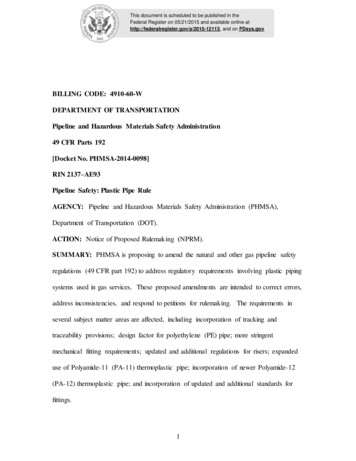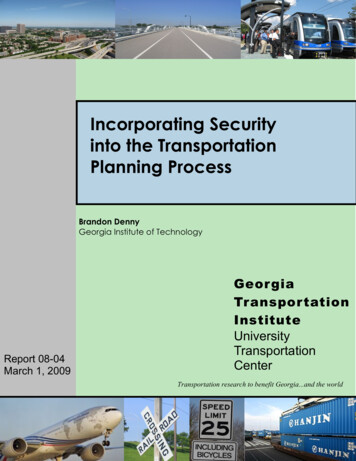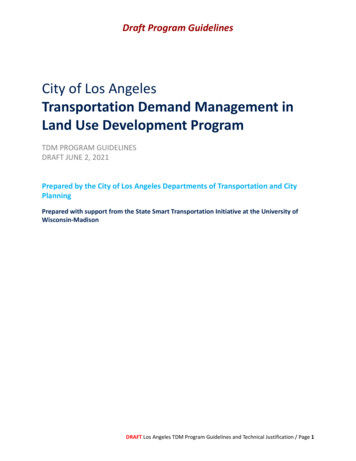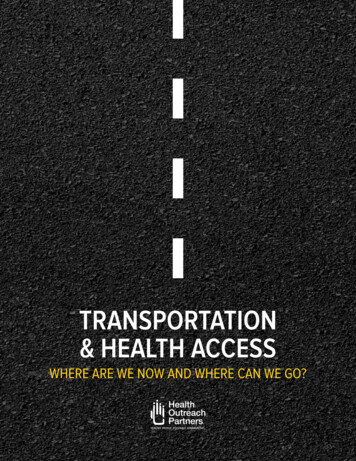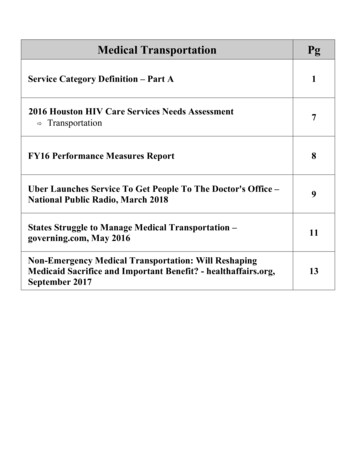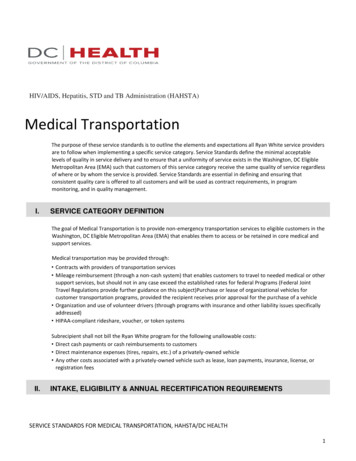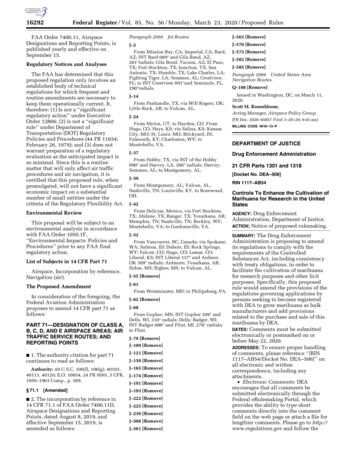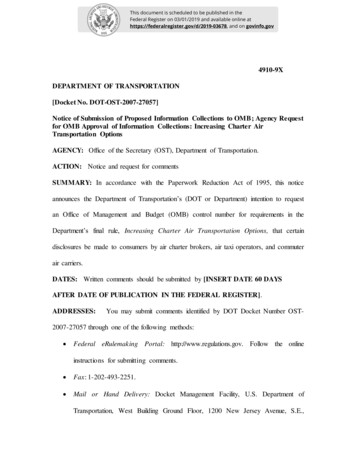
Transcription
This document is scheduled to be published in theFederal Register on 03/01/2019 and available online athttps://federalregister.gov/d/2019-03678, and on govinfo.gov4910-9XDEPARTMENT OF TRANSPORTATION[Docket No. DOT-OST-2007-27057]Notice of Submission of Proposed Information Collections to OMB; Agency Requestfor OMB Approval of Information Collections: Increasing Charter AirTransportation OptionsAGENCY: Office of the Secretary (OST), Department of Transportation.ACTION: Notice and request for commentsSUMMARY: In accordance with the Paperwork Reduction Act of 1995, this noticeannounces the Department of Transportation’s (DOT or Department) intention to requestan Office of Management and Budget (OMB) control number for requirements in theDepartment’s final rule, Increasing Charter Air Transportation Options, that certaindisclosures be made to consumers by air charter brokers, air taxi operators, and commuterair carriers.DATES: Written comments should be submitted by [INSERT DATE 60 DAYSAFTER DATE OF PUBLICATION IN THE FEDERAL REGISTER].ADDRESSES:You may submit comments identified by DOT Docket Number OST-2007-27057 through one of the following methods: Federal eRulemaking Portal: http://www.regulations.gov. Follow the onlineinstructions for submitting comments. Fax: 1-202-493-2251. Mail or Hand Delivery: Docket Management Facility, U.S. Department ofTransportation, West Building Ground Floor, 1200 New Jersey Avenue, S.E.,
Room W12-140, Washington, DC 20590, between 9 a.m. and 5 p.m., Mondaythrough Friday, except on Federal holidays. The telephone number is 202-3669329.FOR FURTHER INFORMATION CONTACT: Sohum Karia, Office of the GeneralCounsel, Office of the Secretary, U.S. Department of Transportation, 1200 New JerseyAvenue, SE, Washington, DC, 20590, 202-366-9342 (Voice), 202-366-7152 (Fax), orsohum.karia@dot.gov (Email).Arrangements to receive this document in an alternativeformat may be made by contacting the above-named individual.SUPPLEMENTARY INFORMATION:Title: Increasing Charter Air Transportation OptionsType of Review: New Information CollectionsBackground: This notice concerns two new information collection requirements in theDepartment’s final rule, Increasing Charter Air Transportation Options, 83 Fed. Reg.46867 (September 17, 2018), which is effective on February 14, 2019. Under the finalrule, air charter brokers1 are authorized to act as indirect air carriers2 by contracting intheir own right with customers to provide charter air transportation and separatelyarranging with direct air carriers to provide such transportation services.The first1The final rule defines an air charter broker as “any person or entity that, as an indirect air carrier, foreignindirect air carrier, or a bona fide agent, holds out, sells, or arranges single entity charter air transportationusing a direct air carrier.”2“Indirect air carrier” means any person who undertakes to engage indirectly in air transport ationoperations and who uses for such transportation the services of a direct air carrier. 14 CFR 380.2. “Directair carrier” means a certificated commuter or foreign air carrier, or an air taxi operator registered under 14CFR Part 298, or a Canadian charter air taxi operator registered under 14 CFR Part 294, that directlyengages in the operation of aircraft under a certificate, authorization, permit or exemption issued by theDepartment. Id.2
information collection pertains to the requirement that air charter brokers disclose in allsolicitation materials and advertisements that they are air charter brokers and not directair carriers.The second information collection involves the requirement that air charterbrokers, air taxi operators, and commuter air carriers provide notification to consumerscontaining pertinent information regarding the terms of the charter air transportation atthe time a consumer is considering the purchase of air transportation. If the informationis not known at that time or changes thereafter, then the entities must provide notificationwithin a reasonable time after the information becomes known.This information isintended to aid the prospective charterer in making a more informed choice regarding thepurchase of charter air transportation, and to facilitate travel by reducing the possibilitythat the consumer will be misled or ill-informed about key information regarding a givenflight before and during his or her trip.The title, a description of the information collection and respondents, and the periodicreporting burden are set forth below for each of the information collections:1. Requirement to disclose that air charter brokers are not direct air carriers inadvertising and solicitation materials (14 CFR § 295.23)All air charter broker solicitation materials and advertising, including Internetwebpages, must clearly and conspicuously state that the air charter broker is not a directair carrier in operational control of aircraft, and that the air service advertised would beprovided by a properly licensed direct air carrier.Respondents: Air charter brokers.3
Estimated Number of Respondents: 700.To reach this estimate, the Departmentbegan by determining the approximate number of flights arranged by air charter brokersannually, using flight records information from the air traffic control radar system anddata reports from private sector aviation research organizations.3These data indicateannual flight activity by these operators of between 760,000 and 1.1 million flights, asshown in Table 1 below.4Table 1: Part 135 Non-ScheduledPassenger Flights per Fiscal Year200620072008200920102011Part 135 Non-Scheduled 0,003870,619The Department utilized the most recent figure of 870,619 FY2011 Part 135 Non Scheduled Passenger Flights (see Table 1).Not all of these flights are revenue flights,since aircraft must sometimes be positioned to meet customers. Although the frequencyof non-revenue positioning flights is generally non-public, the Department, based ondiscussions with parties knowledgeable about this aspect of the industry, estimates that25 percent of non-scheduled passenger flights are non-revenue, meaning that 75 percent,3These data are developed from the Enhanced Traffic Management System (ETMS) flight records, and relyon aircraft and user classifications made by air traffic controllers as well as tail number and operator data.The development of these data for the Federal Aviation Administration (FAA) Business model is presentedin the report “Air Traffic Services Business Model: Overview, Model Description and Applications withSupporting Documentation, Final Report”, September 2011, prepared for the FAA by GRA, Incorporated, acontractor.4Based on the data developed by GRA, Incorporated, for the FAA, Table 1 displays annual flight activityfor non-scheduled Part 135 passenger operations from Fiscal Year 2006 through Fiscal Year 2011. TheDepartment was unable to supplement Table 1 with data from s ubsequent fiscal years, as FAA has ceasedmaintaining the information. Nevertheless, the Department believes that data from FY2012-2017 wouldnot alter our analysis.4
or 652,964 (870,619 75%) are revenue flights.revenue air charter flights arranged by brokers.We then estimated the percentage ofThere was no firm industry estimate ofthis value, so we assumed a midrange estimate of 30 percent5 , resulting in a value ofapproximately 195,889 (652,964 x 30%) non-scheduled passenger flights arranged by aircharter brokers per year. In response to its Notice of Proposed Rulemaking (NPRM), theDepartment received no public comments disputing this assumption.The Department sought to derive the number of respondents from the 195,889 flightsby estimating of the number of flights arranged annually by the average air charterbroker.However, since there was no reliable data on the number of flights arranged bythe average air charter broker, we considered various estimates of the number of aircharter brokers based on general industry knowledge, avoiding selection of extremeoutliers. For instance, because the industry includes both large and small entities, we didnot consider an extremely low estimate of five respondents, which would amount toapproximately 39,200 (195,889/5) flights arranged annually by each broker, and wouldnot account for the relatively lower business volume of smaller entities.Similarly, wedid not consider extremely high estimates, such as 10,000 respondents, which wouldamount to approximately 20 flights arranged annually by each broker, and would notaccount for the relatively higher business volume of larger entities.Ultimately, ourapproach yielded an estimate of 700 respondents, with an estimated 280 flights arrangedannually per broker (195,889/700).5The Department also considered a low estimate of 20 percent, resulting in a value of 130,593 flights, anda high estimate of 40 percent, resulting in a value of 261,186. In order to reach a more definitive estimateof the number of respondents , this notice focuses on the midrange estimate of 30 percent.5
A value of 700 respondents is reasonable based on public comments in response tothe NPRM. These comments noted that the industry has relatively low barriers to entryand therefore is likely comprised of many small air charter brokers operating in themarketplace, in addition to a few dozen larger, more established, and well-knowncompanies. Therefore, many of those 700 would likely arrange fewer than the average of280 flights annually, and a few dozen would likely arrange more than that average.Accordingly, given our assumption of 195,889 total annual flights arranged by air charterbrokers, we estimate that approximately 700 respondents will be subject to the rule’sinformation collection requirements pertaining to air charter brokers.Frequency: 15 minutes per flight, for approximately 280 flights per year.Theestimate of 280 flights derives from our assumption of 195,889 total annual flightsarranged by air charter brokers and our estimate of 700 air charter broker respondents(195,889/700).We believe that the burden required for an air charter broker to complywith this disclosure requirement by changing a small portion of an air charter broker’sadvertising webpages or printed materials would be minimal.To quantify the estimatedburden, it was assumed that accomplishing these disclosures takes 15 minutes of the timeof a qualified sales staff person employed by the air charter broker, comprised of 10minutes required to draft the language to be used and 5 minutes to post this informationon the air charter broker’s website.It was also assumed that each flight involves oneadvertisement or solicitation material, though this is likely an overestimate given thatsuch materials in this industry are primarily displayed or sent electronically to many6
consumers with identical content and form, resulting in minimal burden to the broker perindividual consumer.Estimated Annual Burden per Respondent: 70 hours, given that each advertisement orsolicitation material would require a burden of 15 minutes, and that each air charterbroker will arrange an estimated 280 flights per year (280 x .25 hours).However,discussions with individuals knowledgeable about the current air charter broker industryindicated that making the required disclosures is already customary business practice in asignificant part of the industry. Comments received in response to the NPRM confirmedthe Department’s prior understanding.Thus, the burden of compliance with this aspectof the final rule will be minimal for entities in the air charter broker industry.Estimated Total Annual Burden: 49,000 hours. This figure derives from our estimateof 700 respondents, with approximately 70 hours annually per respondent (700 x 70hours).Alternatively, the estimate of 49,000 hours results by multiplying our previouslystated estimates of 195,889 total annual flights arranged by air charter brokers and aburden of 15 minutes per flight (195,889 x .25 hours 48,972).2. Requirement for air charter brokers, air taxi operators, and commuter air carriersto charterers to provide certain disclosures to consumers (14 CFR sections 295.24and 298.80)The final rule requires that before entering a contract for a specific flight or series offlights with charterers, air charter brokers must make the following disclosures: (a) Thecorporate name of the direct air carrier or direct foreign air carrier in operational controlof the aircraft on which the air transportation is to be performed and any other names in7
which that direct carrier holds itself out to the public; (b) The capacity in which the aircharter broker is acting in contracting for the air transportation, i.e., as an indirect aircarrier, indirect foreign air carrier, as an agent of the charterer, or as an agent of the directair carrier or direct foreign air carrier that will be in operational control of the flight; (c)The existence or absence of liability insurance held by the air charter broker covering thecharterer and passengers and property on the charter flight, and the monetary limits ofany such insurance.The final rule further requires that before entering a contract for a specific flight orseries of flights with charterers, air charter brokers must make the following disclosuresupon request of the charterer, prior to the start of the air transportation: (a) If the aircharter broker is acting as the agent of the charterer, the air charter broker must disclosethe existence of any corporate or business relationship, including a preexisting contract,between the air charter broker and the direct air carrier or direct foreign air carrier thatwill be in operational control of the flight that may have a bearing on the air charterbroker’s selection of the direct carrier that will be in operational control of the flight; (b)The total cost of the air transportation paid by the charterer to or through the air charterbroker, including any air charter broker or carrier-imposed fees or government-imposedtaxes and fees. Specific individual fees, taxes, or costs may, but are not required to beitemized. The total cost of the air transportation is not required to include fees chargedby third-parties; (c) The existence of any fees and their amounts collected by thirdparties, if known (or a good faith estimate if not known), including fuel, landing fees, and8
aircraft parking or hangar fees, for which the charterer will be responsible for payingdirectly.If any of the information that is required to be disclosed to the charterer or requestedby the charterer to be disclosed is not known at the time the contract is entered into orchanges thereafter, air charter brokers must provide the information to the chartererwithin a reasonable time after such information becomes available to the air charterbroker, such that the charterer has enough time to make an informed decision as towhether to accept the additional information or accept the change.If the information that is required to be disclosed to the charterer or requested by thecharterer to be disclosed changes after the air transportation covered by the contract hasbegun, air charter brokers must provide information regarding any such changes to thecharterer within a reasonable time after such information becomes available to the aircharter broker.In addition, the final rule requires that before entering a contract for a specific flightor series of flights with charterers, air taxi operators and commuter air carriers must makesimilar disclosures, prior to the start of the air transportation.For example, they mustdisclose that the flight will be performed by another direct air carrier or direct foreign aircarrier if that is the case, as well as the corporate name of the direct air carrier or directforeign air carrier in operational control of the aircraft on which the air transportation isto be performed and any other names in which that direct carrier holds itself out to thepublic.If the flight is to be performed by another direct air carrier or direct foreign aircarrier, they must disclose the capacity in which the air taxi operator or commuter air9
carrier is acting in contracting for the air transportation, i.e., as a principal, as an agent ofthe charterer, or as an agent of the direct air carrier that will be in operational control ofthe flight.Air taxi operators and commuter air carriers must also make the following disclosuresupon request of the charterer, prior to the start of the air transportation: (a) If the flight isto be performed by another direct air carrier or foreign direct air carrier and the air taxioperator or commuter air carrier is acting as the agent of the charterer, the air taxioperator or commuter air carrier must disclose the existence of any corporate or businessrelationship, including a preexisting contract, between the air taxi operator or commuterair carrier and the direct carrier that will be in operational control of the flight that mayhave a bearing on the air taxi operator’s or commuter air carrier’s selection of the directcarrier that will be in operational control of the flight; (b) The total cost of the airtransportation paid by the charterer to or through the air taxi operator or commuter aircarrier, including any carrier-imposed fees or government-imposed taxes and fees.Specific individual fees, taxes, or costs may, but are not required to be itemized.Thetotal cost of the air transportation is not required to include fees charged by third parties;(c) The existence of any fees and their amounts collected by third parties, if known (or agood faith estimate if not known), including fuel, landing fees, and aircraft parking orhangar fees for which the charterer will be responsible for paying directly.If any of the information that is required to be disclosed to the charterer or requestedby the charterer to be disclosed is not known at the time the contract is entered into orchanges thereafter, air taxi operators and commuter air carriers must provide the10
information to the charterer within a reasonable time after such information becomesavailable to the air taxi operator or commuter air carrier, such that the charterer hasenough time to make an informed decision as to whether to accept the additionalinformation or accept the change.If the information that is required to be disclosed to the charterer or requested by thecharterer to be disclosed changes after the air transportation covered by the contract hasbegun, air taxi operators and commuter air carriers must provide information regardingany such changes to the charterer within a reasonable time after such informationbecomes available to the air taxi operator or commuter air carrier.Respondents: Air taxi operators; commuter air carriers operating or arranging nonscheduled, charter flights operated pursuant to Federal Aviation Regulations (FAR) Part135 and 14 CFR Part 298; and air charter brokers.Estimated Number of Respondents: 2,855, of which 2,1556 are air taxi operators andcommuter air carriers and 700 are air charter brokers.Frequency: 15 minutes per flight, for approximately 280 flights per year.Theestimate of 280 flights derives from our assumption of 195,889 total annual flightsarranged by air charter brokers and our estimate of 700 air charter broker respondents(195,889/700).For each air charter broker transaction, discussions with individualsknowledgeable about the current air charter broker industry indicated that the timerequired for an air charter broker to record and share the necessary data elements with acharterer was modest. To estimate the cost of this for air charter brokers not currently6This estimate is based on October 2012 FAA data. “Study of Operators Regulated Under Part 135,” at ES2, Federal Aviation Administration (April 2016), available at: http://nata.aero/data/files/gia/4656 001.pdf.11
providing charterers with the identified disclosures, it is assumed that accomplishing thedisclosures takes 15 minutes of the time of a qualified sales staff person employed by theair charter broker. Part of the justification for this time estimate is that the information tobe disclosed is comprised of data elements that arise naturally from the arrangement of aflight operated by a direct air carrier.Given the substantive similarity of the disclosuresrequired of air taxi operators and commuter air carriers, the Department assumed thatthey also require no more than 15 minutes per transaction.Estimated Annual Burden on Respondents: 70 hours for air charter brokers, assuming15 minutes per transaction and 280 transactions per year per respondent (280 x .25hours).Regarding the estimated 2,155 taxi operators and commuter air carriers, givenour previously stated estimate of 652,964 non-scheduled passenger revenue flightsoperated annually under Part 135, we estimate approximately 303 (652,964/2,155)transactions annually per air taxi operator or commuter air carrier. Assuming 15 minutesper transaction, we estimate the total annual burden per respondent to be approximately75 hours and 45 minutes (303 x .25 75.75).However, discussions with individualsknowledgeable about the industry indicated that making these disclosures to charterers isalready a standard part of customary and usual business practices for air charter brokersas well as air taxi operators and commuter air carriers. Thus, these entities should expectlittle or no incremental burden due to these disclosure requirements, as supported bycomments received in response to the Department’s NPRM.Estimated Total Annual Burden: The estimated total annual burden would be 212,241hours and 15 minutes.Regarding air charter brokers, based on the estimate of 70012
respondents, with approximately 70 hours annually per respondent, the estimated totalannual burden of the flight-specific disclosure requirements would be 49,000 hours.Regarding air taxi operators and commuter air carriers, based on the estimate of 2,155respondents, with approximately 75.75 hours annually per respondent, the estimated totalannual burden would be 163,241 hours and 15 minutes (2,155 x 75.75).As statedpreviously, the total annual incremental burden to air taxi operators and commuter aircarriers is expected to be minimal to none, since making these disclosures is alreadystandard practice for this segment of the industry.Public Comments Invited: You are asked to comment on any aspect of this informationcollection, including (a) whether the proposed collection of information is necessary forthe Department’s performance; (b) the accuracy of the estimated burden; (c) ways for theDepartment to enhance the quality, utility, and clarity of the information collection; and(d) ways that the burden could be minimized without reducing the quality of the collectedinformation.The agency will summarize and/or include your comments in the requestfor OMB’s clearance of this information collection.Authority: The Paperwork Reduction Act of 1995; 44 U.S.C. Chapter 35, as amended;and 49 CFR 1:48.Issued in Washington, DC on February 22, 2019.Blane A. Workie,Assistant General Counsel for Aviation Enforcement and Proceedings.[FR Doc. 2019-03678 Filed: 2/28/2019 8:45 am; Publication Date: 3/1/2019]13
The development of these data for the Federal Aviation Administration (FAA) Business model is presented in the report "Air Traffic Services Business Model: Overview, Model Description and Applications with Supporting Documentation, Final Report", September 2011, prepared for the FAA by GRA, Incorporated, a contractor.
![DEPARTMENT OF TRANSPORTATION [4910-EX-P] Federal Motor Carrier Safety .](/img/57/unified-carrier-registration-plan-fees.jpg)
